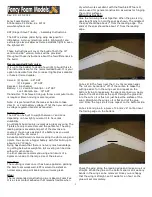
_
54
_
55
_
EN
By active flying we mean the constant control and correction of the
angle of attack in turbulent air. For example, if a pilot flies from an area
of lift to an area of sink, if there is no pilot input, the angle of attack will
be reduced and the wing will pitch forward. Reduced brake pressure will
indicate the start of this pitch movement to the pilot.
The correct reaction is to increase the brake input to prevent the
forward pitch.
Some of the required techniques can be practised during ground handling,
for example, by attempting to keep the wing flying above your head without
looking at it. This exercise is also useful for successful forward launches.
Accelerated flight
Fitting the speed system
The majority of harnesses are fitted with two pulleys per side. Some
(lightweight) harnesses instead have two simple rings or loops.
The two speed bar cords are pulled from top to bottom through both
pulleys/rings and fitted to the foot bar.
The correct length adjustment is important. If it is too short, there is the
danger that the wing is constantly accelerated, which should be avoi-
ded at all costs. If the cords are too short there is the risk that the speed
bar is unreachable.
If the cords are set too long, it is not possible to accelerate the wing to
its maximum speed.
We recommend setting the cords a little too long when first fitting the
speed system, so that the free play can be judged during flight. Then
the slack can be taken up if necessary. Brummel hooks with three
holes assist with the simple adjustment of the cord length.
Using the speed system
Before take off or on connecting the risers to the harness, the Brummel
hooks on the speed system must to attached to those on the harness.
Please make it part of your pre-flight routine to connect the speed
system – it is important for your safety.
The DOUBLESKIN is fitted with a very effective and smooth-run-
ning speed system. Up to the maximum speed, the glide performance
remains very high. Pitch correction, i.e. active flying, in accelerated flight
should not be performed through the brakes, but using the speed system.
Holding pins
By means of small loops and wooden pins the paraglider can be easily
secured for take-off in very steep and slippery terrain – e.g. on snow.
This prevents the glider from sliding down while being laid out. If you
inflate the canopy, the pins will release automatically. The pins can
be attached to the specially provided tabs of the wing using the loops
provided.
Importand:
Please make sure you remove the pins before folding the
glider. You should store them separately to avoid damage to the sail
cloth.
Tow launch
When towing, the DOUBLESKIN displays no peculiarities. Please note
that it is important to climb away from the ground at a shallow angle.
We recommend the use of a tow adapter. This adapter is connected to
the main carabiners and links them with the tow release.
Normal flight
The DOUBLESKIN has its best glide performance at trim speed, i.e.
when the brakes are fully released. In calm air, the wing will travel the
greatest distance over a given height.
With headwind or a sinking airmass, maximum glide can be achieved
by using the speed system. During accelerated flight in turbulent air,
attention should be paid to the dynamic reaction of the wing in case of a
collapse. Lots of height above the ground is advisable.
In strong turbulence it is advisable to gently pull both brakes to increase
stability. The brakes provide feedback about the surrounding air, which
is needed for active flying.
Please note: using
the brakes during
accelerated flight is
not only detrimental
to performance,
but (in comparison
to non-accelerated
flight) it increased
to likelihood of
collapses!
!
Cases of an
escalation of a
collapse can be
prevented by
active flying.
!
Take off:
For an
optimal inflation
we recommend holding
both
A-risers together with the B-riser
and applying little force. That
way, the wing climbs cleanly and reliably above the pilot.
TIP
Содержание DOUBLESKIN
Страница 1: ...Manual _DE _EN ...













































